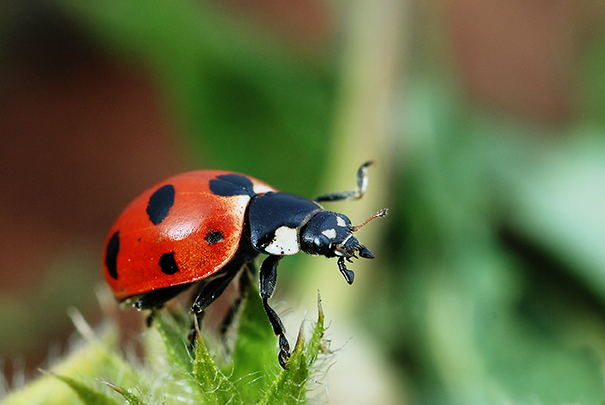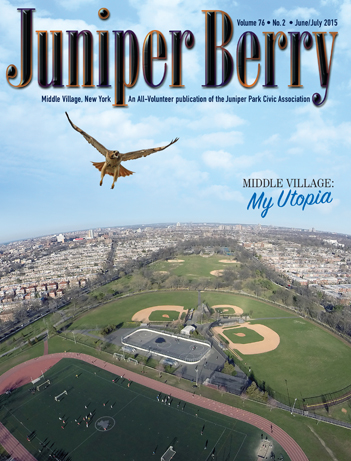Ladybird, Ladybeetle, Ladybug
Bright red-orange ladybug beetles are a welcome sight in these warmer months, especially after the long, cold dreary winter we experienced this past year.
Ladybugs are very healthy for your garden as their favorite food is aphids, pesky insects that destroy vegetation. In fact, they are now being used as pest control at farms and gardens instead of chemicals.
They are not poisonous, at least not to humans or pets. They taste bad to certain predators, and their color serves as a warning to crows, dragonflies, wasps and other insects that might want to munch on them.
Ladybugs hibernate in large groups in winter to stay warm. They especially like to hide underneath house siding.
For the Virgin Mary
According to LadyBugLady.com, “in Europe, during the Middle Ages, insects were destroying the crops, so the Catholic farmers prayed to the Virgin Mary for help. Soon the Ladybugs came, ate the plant-destroying pests and saved the crops! The farmers began calling the ladybugs ‘The Beetles of Our Lady’ and they eventually became known as “Lady Beetles”! The red wings represented the Virgin’s cloak and the black spots represented her joys and sorrows.”
So yes, there are male ladybugs. And even though we all believed the myth as kids, their spots do not indicate how old they are – it’s just a pattern, similar to stripes on a cat. The pattern tends to fade with age, and some ladybugs have no spots at all.
There actually are more than 500 species of ladybugs in the U.S. and more than 5000 worldwide. They come in all different colors as well. If you would like to attract ladybugs to your garden, then the best flower varieties to plant are: agastache, dill, lobelia, scabiosa, coneflower, coreopsis, lavender, milkweed, yarrow and cosmos.
The Missing Monarchs
It was both surprising and saddening to hear that the monarch butterfly population is crashing at an alarming rate. Some estimates have the decimation as high as 90% over the past 20 years. Having grown up in the city, the most abundant butterfly around always seemed to be the monarch, after the ubiquitous cabbage white.
The decline of the monarch is due to several factors: chemical farming practices, overdevelopment, climate change, and illegal logging which have destroyed their habitat.
Butterflies lay their eggs on milkweed and the resultant larvae and caterpillars are dependent on that milkweed for food. With milkweed plants on the decline, the butterfly population is suffering. But there are some things that local gardeners and non-gardeners can do to help the monarch.
Plant milkweed!
You can purchase a milkweed kit from monarchwatch.org and it has everything in it that you need for your garden. The monarch caterpillars feed on the leaves. Plant flowers such as zinnias, cosmos, coneflowers and daisies in your garden for the adults seeking nectar. DO NOT use pesticides in your garden.
Butterflies also need sources of water, so a fountain or birdbath would also help them out. What’s not recommended is to buy a butterfly house. The butterflies actually prefer to roost high up in trees at night and generally won’t use a house – although other undesirable species might.
Another thing you might want to consider is eating organic. The more people that reject genetically modified crops and foods treated with pesticides, the better it will be for the butterflies – and the environment in general.
Bats are misunderstood mammals
What is the first thing you think of when you hear the word “bats”? Some think of Dracula. Others think of Batman. A few may think of bats in the belfry. Still others may think bats are cool flying mammals, but that we don’t encounter them here in NYC. Well, if the last vision is yours, you may want to think again.
Bats are most certainly present here in Queens and throughout NYC. The most common species is Little Brown Bat (Myotis lucifugus), although there are others. The average lifespan of this bat species is 6 to 7 years, although they frequently will last 10 or more years.
Little Brown Bats can most commonly be found in parks and cemeteries, although they have been known to invade homes via open windows. The young ones, which arrive in late spring, are especially susceptible to becoming confused and mistakenly ending up inside someone’s house.
Bats are most active at night. During the day, they roost mainly in trees and sometimes inside abandoned buildings in our area. They may also sleep under rocks or wood piles. If there’s a cave around, they’ll inhabit that, too.
Yes, bats do roost upside-down. This puts them in an ideal position for escape, if necessary, because they can’t take flight from the ground. Instead, they must “fall into flight” from a high spot. They also are smart enough to sleep where most predators, such as birds of prey, can’t get at them.
Little Brown Bats do one of two things in the winter, when food is scarce. They either enter a state of hibernation, or migrate to warmer areas.
Despite what many believe, bats do not suck blood and are not attracted to people’s hair. A bite from a bat is rare, and contracting rabies from a bat is even rarer. There has not been a case of human rabies infestation in New York in more than 50 years. But it is important to vaccinate all pets against rabies.
The City of New York encourages bats to stay and multiply. Bat houses have been installed in several of our forested public parks, such as Central, Pelham Bay and Forest Parks. Why? Well, bats are quite beneficial to humans and other mammals, because their favorite food is mosquitoes. This means their presence cuts down on West Nile Disease. Little Brown Bats are strict insectivores and in addition to mosquitoes, they’ll eat moths, wasps, beetles, gnats, and mayflies.
If you’re outside at dusk and see something flying that doesn’t quite strike you as a bird, then it’s probably a bat out looking for food. Have no fear. They’re here to help.




